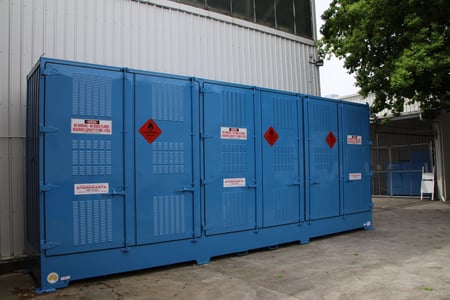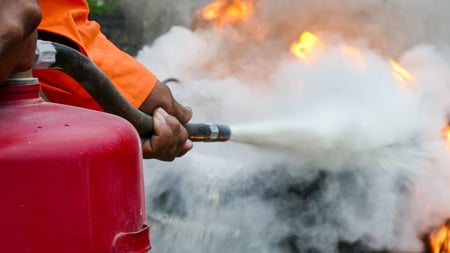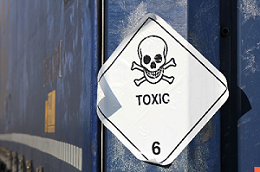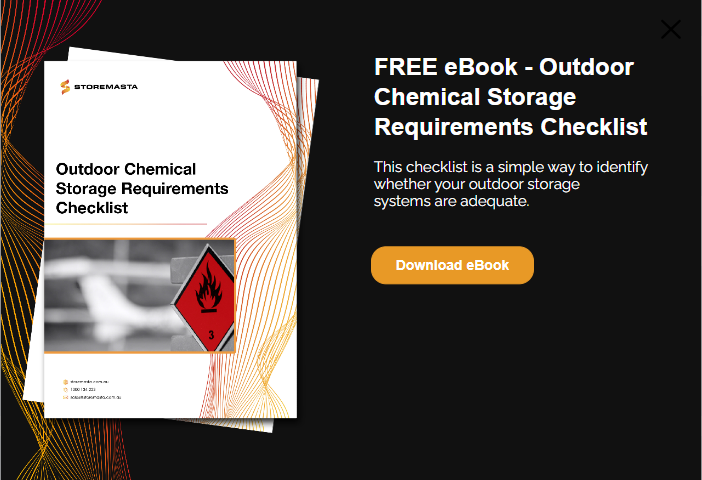Are you carrying large quantities of Dangerous Goods in your organisation? When it comes to storing larger volumes of chemicals in the workplace, additional requirements usually apply. This is because the greater the quantity of Dangerous Goods that you have onsite, the greater the likelihood and impact of a safety hazard. This blog will focus on some of the more commonly used classes of Dangerous Goods — such as toxic substances, flammable liquids and corrosives — and detail the requirements for their storage. We’ll also explain how storing your chemicals in dedicated DG containers or chemical storage containers can effectively reduce your risks.
But let’s get started by first explaining what resources you can use to assist you with determining the hazards associated with your chemicals — as well as your storage needs.
What Documents Can Assist With Storage Compliance?
To achieve chemical compliance in your workplace, it’s essential that you refer to several documents to gain the knowledge necessary to implement the right risk control measures.
While we highly recommend conducting an onsite risk assessment — so you can properly identify any hazards and put in place the appropriate controls — there are some essential documents that can help determine your chemical storage requirements.

Conducting an onsite risk assessment will help you determine your Dangerous Goods storage needs.
To correctly determine your storage requirements, you will need to have copies of:
- WHS Regulations so you can familiarise yourself with your legal obligations
- The Safety Data Sheet (SDS) of each chemical that you have onsite
- The appropriate Australian Standard for the classes of Dangerous Goods that you’re carrying
The WHS Regulations explain your legal obligations in relation to workplace health and safety – including the handling and storage of hazardous chemicals. While not specifically detailing information on the storage of bulk hazardous chemicals, the WHS Regulations does detail obligations in Chapter 7 Hazardous Chemicals.
Some of these obligations include:
- SDSs must be provided by the manufacturer or importer
- SDSs must be obtained by the business no later than when the hazardous chemical is first supplied or as soon as practicable
- SDSs must be readily accessible to workers who use, handle or store the chemical
- Details of the chemical identities must be given to registered medical practitioners and emergency services
- A hazardous chemicals register, including list of hazardous chemicals and their SDSs, must be kept at the workplace
- Hazardous chemicals must be correctly labelled - including chemical containers
Your SDS, however, contains specific details about the chemical product that you’re carrying. These include the class of Dangerous Goods, product ingredients, hazards, stability, reactivity, toxicity, environmental impacts and other important information. The document will also contain the chemical and physical properties of the substance which will dictate how it is stored and handled. These include details on the chemical’s odour, vapour pressure, pH level, melting/freezing point, boiling range, flash point and auto-ignition. The SDS will also explain the product’s chemical compatibility with other substances and materials.
IMPORTANT: To ensure that all personnel, as well as any emergency services that attend your site, have immediate access to your SDSs, we suggest using a document storage holder and attaching it to your DG cabinet or store. Alternatively, you may use a manifest cabinet, which should be located at the entry point of your premises.
Applying The Australian Standards
As we’ve explained, the WHS Regulations set out the safety requirements and obligations for all Australian workplaces. The SDS explains all the properties and hazards associated with the chemical. However, when it comes to understanding the exact measures that you must put in place for the areas of your business that carry Dangerous Goods, you should refer to the Australian Standards.
The Standards offer more detailed advice on procedures, protocols, risk control measures, PPE, staff training and other important safety measures. We’ll list some of the requirements for common classes of Dangerous Goods, including flammable liquids, oxidising agents, organic peroxides, toxic substances and corrosive substances, below in further detail.
IMPORTANT: Storing larger quantities of Dangerous Goods can increase the risk of hazards such as human harm, environmental damage, hazardous vapours, chemical spills, fire and explosion. Therefore, many classes of Dangerous Goods must be stored in an outdoor environment instead of indoors. When determining your storage requirements, always refer to the appropriate Australian Standard for full details on store location, construction and other important information, such as segregation from incompatible substances.
Storing Hazardous Chemicals In Larger Volumes
When storing greater quantities of hazardous chemicals (which aren’t categorised as minor storage in the Australian Standards) there are a range of requirements that include the construction and location of the store.
We’ve highlighted some common classes of Dangerous Goods to illustrate the specific requirements for storage for this class of chemical.
Class 3 Flammable Liquids
As the name suggests, the key risks associated with flammable liquids include fire and explosion. However, flammable liquids can also result in hazards including asphyxiation, skin burns, eye damage and environmental pollution.

As flammable liquids pose a fire risk, they must be stored away from ignition sources.
When storing any quantity of flammable liquids you must consider the following:
- Isolation from ignition sources
- Adequate spill containment and management
- Ventilation to reduce and control hazardous vapours
- Separation from incompatible substances and protected places
The Australian Standard AS 1940:2017 – The storage and handling of flammable and combustible liquids details the requirements for flammable liquid stores.
When you’re storing more than 250 L of flammable liquids outside of a commercial building (the maximum quantity to be classed as minor storage), you’ll be subject to the requirements of Section 4 Package Storage and Handling Areas.
The types of stores that apply to the safe storage of large quantities of flammable liquids include:
- Detached store
- Attached fire-separated stores
- Attached store with communicating fire door
- Outdoor storage cabinet
Some general requirements for the construction of flammable liquids stores includes:
- Construction must be made from non-combustible material
- Spillage containment for the flammable liquids – at least 100% of the largest package plus 25% of the storage capacity up to 10 000 L, together with 10% of the storage between 10 000 L – 100 000 L, and 5% above 100 000 L.
- Impervious floors for the spillage catchment which can’t degrade or cause incendive sparking
- Adequate natural or mechanical ventilation
Due to the high level of risk that is associated with the storage of flammable liquids, these stores are equipped with the greatest risk control measures. Due to the complexity of the construction of these stores, Dangerous Goods storage containers or chemical storage containers are often the simplest and most cost-effective storage solution.
Class 5.1 Oxidizing Agents
The hazards associated with the storage of oxidizing agents includes oxidizing reactions, spontaneous fires, chemical spills, human harm due to toxicity and potential corrosive effects on the human skin as well as other workplace materials.

When storing oxidizing agents in your workplace, you must reduce risks including spontaneous fire, chemical spills and human harm.
When oxidizing agents are stored in quantities greater than those detailed in minor storage, they are subject to the requirements of Section 4 of AS 4326:2008 – the storage and handling of oxidizing agents.
Minor stores are classed as stores with a maximum capacity of 50 kg/L for PG I, 250 kg/L for PG II and 1000 kg/L for PG III (not including farms). However, if you’re storing greater quantities of oxidizing agents, 250 litres or more, then you must place these packaged chemicals in an outdoor store.
Requirements for the construction of package stores includes:
- Must be constructed from non-combustible materials
- Materials must be resistant to attack by the oxidizing agents being stored
- Shelving must be designed and fitted to prevent oxidizing agents from building up in corners or along ledges
- Racks or shelves must prevent the accumulation or pooling of liquid
- Stores require natural or mechanical ventilation to prevent accumulation of harmful vapours or dusts
- The storage area must contain a spill with the capacity being:
- PG I – 100% of aggregate volume of liquids kept
- PG II or III – 25% of aggregate volume of liquids kept
If you are storing your oxidizing agents outdoors, you must ensure that:
- Your storage area is compliant
- The product (check the SDS), container and label won’t be adversely affected by the elements
- The store is away from any building
- Crystalline structure of the oxidizing agents won’t be affected by the storage conditions
- They are stored away from incompatible substances
Class 5.2 Organic Peroxides
As a thermally unstable substance, organic peroxides pose a range of risks to the businesses that carry them. This class of Dangerous Goods has the potential to burn rapidly, react with other substances and be sensitive to friction or impact.
The most significant risk associated with organic peroxides is that they may cause an exothermic self-accelerating decomposition. This means that these chemicals can explode if they’re not stored correctly.
AS 2714:2008 – The storage and handling of organic peroxides is the Australian Standard that relates to this class of Dangerous Goods.
Minor storage of organic peroxides is classed as the storage of Types C, D, E and F in packages individually containing no more than 5 kg/L – and a total quantity of no more than 20 kg/L.
When quantities exceed those stated in minor storage, then your stores of organic peroxides fall under the requirements for package stores. However, if you have 50 litres+ (Type B) or 100 litres+ (Type C, D, E) of organic peroxides, you must store these Dangerous Goods in an outdoor store.
Requirements for organic peroxide stores include:
- Separation from property boundary, adjoining public street, railway line, protected places and boundaries of adjoining properties
- Segregation from other classes of Dangerous Goods or incompatible substances
- Ventilation at high and low levels in the store
- Spillage control
- Control of ignition sources
- Temperature control measures – such as vents
- Provision for adequate supply of water for leaks, spills, first aid
- Separation from incompatible substances
Class 6.1 Toxic Substances
Human harm is the key risk associated with the storage of toxic substances. These hazardous chemicals can cause severe harm and fatalities if they come into contact with the human body through ingestion, inhalation or skin absorption.
The 3 packing groups of toxic substances present different degrees of danger, with PG I being the most toxic and PG III having a relatively low toxicity.
If you are storing more 250 litres or more of toxic substances in your workplace, you are required to house them in an outdoor location.

Toxic substances must be stored in a compliant manner to reduce the risk of human harm and environmental damage.
The Standard which details the control measures applicable for this class of Dangerous Goods is AS NZS 4452:1997 – The storage and handling of toxic substances. In Section 4.2 Types of package stores, the Standard explains that toxic substances may be stored in a freestanding, roofed structure or building, an outdoor storage area with security fence or an outdoor store.
Construction requirements include:
- Constructed from non-combustible material that’s resistant to attack by the chemicals stored
- Adequate ventilation
- Spill containment – for PG I 100% of the aggregate volume of liquids, PG II and III 25% of the aggregate volume of liquids
- At least 2 means of access for stores exceeding 25 m 2 of floorspace
- Stores secured against unauthorised entry
Some of the general requirements for toxic substance stores include specifics on the location of the store. These include:
- Separation from protected places, public places and boundaries of other premises
- Separation from water courses and open stormwater channels
- Located above the highest recorded flood level
- Located away from any accumulated flammable or combustible materials
- Segregation from incompatible substances
Class 8 Corrosive Substances
Corrosive substances can chemically attack materials — including living tissue and metal. If these chemicals are mishandled or they spill into the workplace, they can cause destruction to people, property and the environment – including fauna and aquatic life.
When you’re storing 850 litres or more of corrosive substances, these chemical packages must be placed in an outdoor store. According to AS 3780:2008 – The storage and handling of corrosive substances, the store may a designated open-air location or a freestanding, roofed structure or building.
The general requirements for package stores of toxic substances include:
- At least 2 means of access for stores exceeding 25 m 2 of floorspace
- Designed and constructed to allow for compliant housekeeping requirements
- Construction materials must be corrosion resistant or lined with corrosion-resistant materials
- Adequate ventilation
- Spill containment with the capacity to be 25% of the aggregate volume of liquids or the capacity of the largest container, but need not exceed 5000 L where only packages are kept
- Stores must be secured against unauthorised entry
It’s also important to note that corrosive substances must be segregated into acids and bases. Even though these chemicals are both classed as corrosives, they are incompatible and must not be mixed — or they can produce dangerous reactions. We suggest conducting a risk assessment before applying control measures to your corrosive substance stores, to properly determine your segregation requirements.
Safe Storage Of Larger Quantities Of Dangerous Goods
As we’ve detailed in this blog, there are many factors to consider when you’re storing larger quantities of Dangerous Goods or hazardous chemicals in your workplace. With limits on the volume of chemicals that you can store indoors, many businesses opt to store their Dangerous Goods in an outdoor location. When choosing and maintaining a chemical store, you must always follow the requirements of the Australian Standards. These not only will help you achieve compliance, but they’ll help you create a safer workplace without any unnecessary guesswork.
One of the easiest ways to achieve chemical compliance when storing larger volumes of hazardous chemicals, is to choose an outdoor store that’s been designed and constructed to meet the requirements of the Australian Standards. These stores are purpose-built to provide safe storage for the class of Dangerous Goods that they are holding, with risk control measures including ventilation, spill containment and a durable construction that won’t react with the chemicals that are being stored. If you’d like to learn more about the requirements for storing chemicals outdoors, why not access our helpful checklist? It’s completely free and yours to download today.
Joining the team as a Dangerous Goods Storage Consultant, Melissa Hampton became Storemasta's Marketing Manager in late 2021. With extensive knowledge and experience in chemical compliance, Melissa is responsible for leading the Marketing team and helping shape their marketing strategy. In her spare time, you can find Melissa hiking, swimming and enjoying the great outdoors in beautiful north-west Tasmania.
